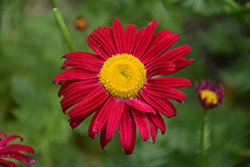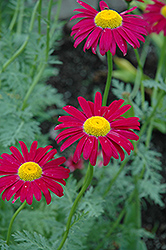Plant Search
Robinson's Red Painted Daisy
Tanacetum coccineum 'Robinson's Red'
Plant Height: 12 inches
Flower Height: 18 inches
Spacing: 14 inches
Sunlight:
![]()
Hardiness Zone: 2
Other Names: Pyrethrum
Description:
A bushy perennial with soft dark green foliage; red daisy like flowers have a bright yellow center and present themselves in early summer; a stiking addition to the garden or massed along borders
Ornamental Features
Robinson's Red Painted Daisy has masses of beautiful red daisy flowers with yellow eyes at the ends of the stems from early to mid summer, which are most effective when planted in groupings. The flowers are excellent for cutting. Its deeply cut ferny leaves remain dark green in colour throughout the season.
Landscape Attributes
Robinson's Red Painted Daisy is an herbaceous perennial with a mounded form. Its relatively fine texture sets it apart from other garden plants with less refined foliage.
This is a relatively low maintenance plant, and should be cut back in late fall in preparation for winter. It is a good choice for attracting butterflies to your yard, but is not particularly attractive to deer who tend to leave it alone in favor of tastier treats. It has no significant negative characteristics.
Robinson's Red Painted Daisy is recommended for the following landscape applications;
- Mass Planting
- General Garden Use
Planting & Growing
Robinson's Red Painted Daisy will grow to be about 12 inches tall at maturity extending to 18 inches tall with the flowers, with a spread of 18 inches. When grown in masses or used as a bedding plant, individual plants should be spaced approximately 14 inches apart. It grows at a fast rate, and under ideal conditions can be expected to live for approximately 5 years. As an herbaceous perennial, this plant will usually die back to the crown each winter, and will regrow from the base each spring. Be careful not to disturb the crown in late winter when it may not be readily seen!
This plant should only be grown in full sunlight. It prefers to grow in average to moist conditions, and shouldn't be allowed to dry out. It is not particular as to soil type or pH. It is highly tolerant of urban pollution and will even thrive in inner city environments. This is a selected variety of a species not originally from North America. It can be propagated by division; however, as a cultivated variety, be aware that it may be subject to certain restrictions or prohibitions on propagation.




